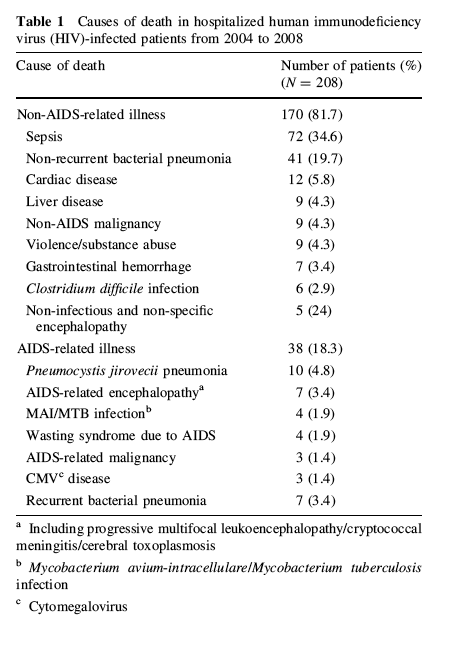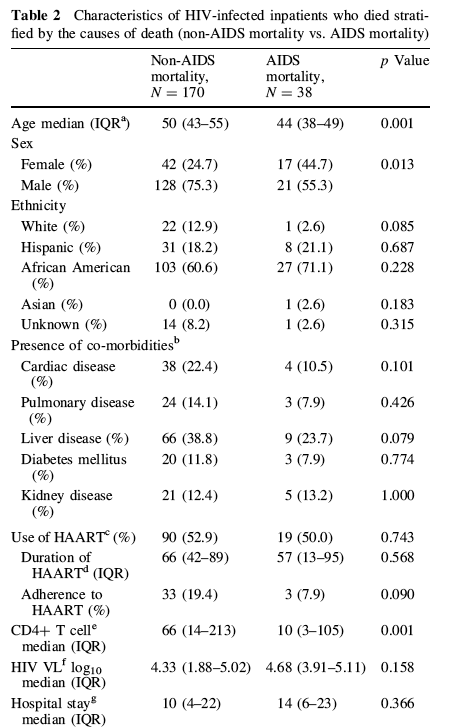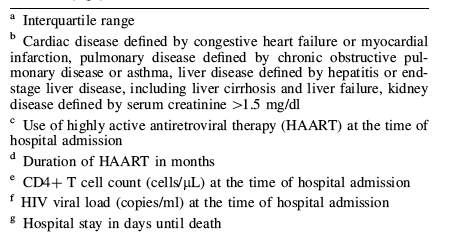| |
All-cause mortality in hospitalized HIV-infected patients at an acute tertiary care hospital with a comprehensive outpatient HIV care program in New York City in the era of highly active antiretroviral therapy (HAART) 2004-2008: Non-AIDS Illnesses were the majority of the causes of deaths including CVD/liver/malignancies/infections
|
| |
| |
Download the PDF here
"Among 9,101 hospitalized HIV-infected patients, St Luke's Hospital NYC.....The majority of [in-patient] deaths were due to non- AIDS-related illness, especially those caused by sepsis and non-recurrent bacterial pneumonia.....our study period was from 2004 to 2008 and did not include more recent years from 2009 to 2011......a look at Tables 1 & 2 below will show you 4.3% of those who died did so due to liver disease, but 38% of those who died due to non-AIDS event had liver disease & 23% of those who died due to AIDS events had liver disease.
Among 9,101 hospitalized HIV-infected patients, 237 deaths were identified, with an overall mortality rate of 237/9,101 (2.6 %). The mortality rate did not differ from year to year (2-3 %). Charts for 208 patients were available for review and were analyzed. The following medians were noted: age 49 years, CD4+ T cell count 137 cells/μL, HIV viral load (VL) log10 3.93, length of stay 16 days. The proportion of men were 71.6 %, African Americans (AAs) were 62.5 %, and HAART use was 52.4 %, with an overall good adherence rate of only 17.3 %.
The major causes of death were non-acquired immunodeficiency syndrome (AIDS)-related illness (81.7 %, 170/208): sepsis (34.6 %, 72/208), non-recurrent bacterial pneumonia (19.7 %, 41/208), cardiac disease (5.8 %, 12/208), liver disease (4.3 %, 9/208), and non-AIDS-related malignancy (4.3 %, 9/208). The major causes of death due to AIDS-related illness (18.3 %, 38/208) were: Pneumocystis jirovecii pneumonia (4.8 %, 10/208) and AIDS-related encephalopathy, including progressive multifocal leukoencephalopathy/cryptococcal meningitis/cerebral toxoplasmosis (3.4 %, 7/208).
Our data demonstrated that significantly more HIV-infected inpatients who died at the hospital due to either liver disease or non-AIDS-related malignancy had admission CD4 T cell count >200 cells/lL. There was significantly more use of HAART with better adherence to HAART in HIV-infected inpatients who died at the hospital with admission CD4 T cell count >200 cells/lL. There was also an increased tendency for better adherence to HAART in HIV-infected inpatients who died due to non-AIDS-related illness. These findings are closely related to recent studies [6, 10, 11] conducted at the outpatient setting among HIV-infected patients with median CD4 T cell count ranging from 287 to 528 cells/lL, in which chronic non-AIDS-related illness, including liver disease, and non-AIDS-related malignancy were the major causes of deaths, suggesting that the proportion of deaths due to non-AIDS-related illness will likely increase among hospitalized
HIV-infected patients with good adherence to HAART."
-----------------
All-cause mortality in hospitalized HIV-infected patients at an acute tertiary care hospital with a comprehensive outpatient HIV care program in New York City in the era of highly active antiretroviral therapy (HAART)
Infection (2013)
J. H. Kim · G. Psevdos Jr. · E. Gonzalez ·
S. Singh · M. C. Kilayko · V. Sharp
Abstract
PURPOSE:
The overall mortality rate among human immunodeficiency virus (HIV)-infected patients has significantly declined in the era of highly active antiretroviral therapy (HAART). However, little is known about the causes of death for HIV-infected patients who are hospitalized in acute care hospitals.
METHODS:
A retrospective chart review of hospitalized HIV-infected patients from 2004 to 2008 was undertaken.
RESULTS:
Among 9,101 hospitalized HIV-infected patients, 237 deaths were identified, with an overall mortality rate of 237/9,101 (2.6 %). The mortality rate did not differ from year to year (2-3 %). Charts for 208 patients were available for review and were analyzed. The following medians were noted: age 49 years, CD4+ T cell count 137 cells/μL, HIV viral load (VL) log10 3.93, length of stay 16 days. The proportion of men were 71.6 %, African Americans (AAs) were 62.5 %, and HAART use was 52.4 %, with an overall good adherence rate of only 17.3 %.
The major causes of death were non-acquired immunodeficiency syndrome (AIDS)-related illness (81.7 %, 170/208): sepsis (34.6 %, 72/208), non-recurrent bacterial pneumonia (19.7 %, 41/208), cardiac disease (5.8 %, 12/208), liver disease (4.3 %, 9/208), and non-AIDS-related malignancy (4.3 %, 9/208). The major causes of death due to AIDS-related illness (18.3 %, 38/208) were: Pneumocystis jirovecii pneumonia (4.8 %, 10/208) and AIDS-related encephalopathy, including progressive multifocal leukoencephalopathy/cryptococcal meningitis/cerebral toxoplasmosis (3.4 %, 7/208).
Mortality due to AIDS-related illnesses was associated with younger age (median age 44 vs. 50 years, p = 0.001), female sex (44.7 vs. 24.7 %, p = 0.013), and lower CD4+ T cell counts (median 10 vs. 66, p = 0.001).
CONCLUSION:
The mortality rate in our hospitalized HIV-infected patients remained low. Non-AIDS-related illnesses were the major causes of death, with sepsis being the most common. Low CD4+ T cell count and female sex were associated with deaths due to AIDS-related illness. Poor adherence to HAART was also noted in those patients to whom treatment was offered in the outpatient setting. Further prospective studies are needed in order to better define the epidemiology and outcomes for hospitalized HIV-infected patients in the era of HAART.
Introduction
Life expectancy for human immunodeficiency virus (HIV)-infected patients has been significantly improved in the era of highly active antiretroviral therapy (HAART), largely due to the reduction in mortality attributable to acquired immunodeficiency syndrome (AIDS)-related illnesses [1]. However, non-AIDS mortality has been increasing. A recent study from New York City that analyzed 12,715 deaths in HIV-infected patients reported to the New York City HIV/AIDS Reporting System and Vital Statistics Registry between 1999 and 2004 identified that non-HIV related causes of death have increased by 32.8 %. This increase was attributed to substance abuse, cardiovascular disease, and non-AIDS-defining malignancies [2]. Also, other recent analyses of HIV cohort studies from Europe and North America showed that more than half of the mortality in HIV-infected patients was due to non-AIDS related illnesses, including non-AIDS malignancies, non-AIDS infections, violence/drug-related causes, liver disease, and cardiovascular disease [3]. Although these large cohort studies showed the trend of increased non-AIDS mortality in HIV-infected patients, little is known about the causes of death for HIV-infected patients who are hospitalized in acute care hospitals. Therefore, we investigated the outcomes of hospitalized HIV-infected patients in order to describe and evaluate the specific causes of death of hospitalized HIV-infected patients in large tertiary acute care hospital in New York City.
St. Luke's-Roosevelt Hospital Center (SLRHc) is a 1,076-bed, full-service, tertiary acute care hospital, serving the Upper West Side of Manhattan, New York City, with an active comprehensive HIV program [the Center for Comprehensive Care (CCC)]. Annually, the CCC offers both outpatient and inpatient medical care to over 5,000 HIV infected patients by HIV-trained doctors. We performed an Institutional Review Board-approved retrospective medical chart review of all adult HIV-infected inpatients who died from 2004 to 2008 at SLRHc.



Discussion
Our study demonstrated an overall mortality rate of 2.6 % for hospitalized HIV-infected patients from 2004 to 2008 at an acute care facility hospital with an active comprehensive HIV program providing both inpatient and outpatient medical care, including access to HAART, in New York City. This inpatient mortality rate for HIV-infected patients was higher than that of HIV-negative patients at the same institution during the study period; however, it was significantly lower than the inpatient mortality rates for HIV-infected patients observed in the United States pre-HAART era (6-12 %) [4, 5]. There are several potential explanations for the decreased mortality rate for HIV-infected inpatients in our patient populations. First, the introduction of HAART has affected the overall mortality of HIV-infected patients by marked reductions in AIDS-related deaths, including deaths from opportunistic infection-related deaths in the United States [6]. In addition, the use of HAART has also led to a decreased number of hospital admissions among HIV-infected patients, from 149,000 in 1995 to 70,000 in 2003 in the United States [7]. As the number of hospital admissions among HIV-infected patients decreases in the era of HAART, the number of physicians with experience in managing the hospital care of HIV-infected patients is likely to decrease as well. However, attending physicians providing inpatient medicalcare for HIV-infected patients at our institution (SLRHc) are staff members of the CCC and all have specialized training in managing HIV-related medical issues and have experience in both outpatient and inpatient settings. Previous studies suggested that greater physician experience in the care of persons with AIDS improves survival [8, 9]. Therefore, our results of an overall low mortality rate for HIV-infected inpatients may indicate the importance of inpatient medical care being provided by physicians with experience in HIV/AIDS in the HAART era.
We found that the majority of HIV-infected inpatients died from non-AIDS-related illness. However, the proportions of specific causes of death from non-AIDS-related illness were significantly different from recent studies [6, 10, 11] conducted at outpatient settings, in which chronic non-AIDS-related illness, including cardiovascular disease, liver disease, and non-AIDS-related malignancy, were the major causes of deaths. In contrast, more than half of the deaths in our study were attributable to acute non-AIDS related illness, including sepsis and non-recurrent bacterial pneumonia. This difference in the proportion of specific causes of non-AIDS-related deaths might be explained by the severity of medical illness of HIV-infected patients, which require inpatient care versus outpatient care. Recent studies conducted among critically ill HIV-infected patients admitted to the intensive care unit (ICU) in the era of HAART revealed that major causes for ICU admission were respiratory failure, including bacterial pneumonia and PCP, followed by sepsis [12-15] with the changing epidemiology of decreased numbers of PCP diagnoses [13, 14]. Of note, low CD4 T cell count [15-17] and diagnosis of sepsis [12, 15, 17] were independently associated with increased hospital mortality in critically ill HIV-infected patients. Furthermore, bacterial infections [18, 19] and bacterial pneumonia [20] were increasingly found in HIV-infected patients with low CD4 T cell count. Given the low CD4 T cell count (median 137 cells/lL) at the time of hospital admission in our cohort of HIV-infected
patients who died in the hospital, the results of our study may indicate that patterns of mortality in hospitalized HIV-infected patients closely resemble those of critically ill HIV-infected patients admitted to the ICU in the era of HAART.
Several variables, including female sex and lower CD4 T cell count, were associated with mortality in HIV infected inpatients due to AIDS-related illness in our study. Also, there was the tendency of a lower adherence rate of HAART in the AIDS mortality group. These results are similarly related to findings from previous studies, which may explain the possible association with mortality due to AIDS-related illness; women were also less likely to receive HAART [21] and were associated with increased AIDS disease progression, as well as decreased survival in the HAART era [22], not only from inequalities in the access to HAART, but also possibly from psychosocial factors, such as active substance abuse, lack of social support, and depression [21]. Lower CD4 T cell count and higher HIV viral load have been associated with advanced AIDS disease [23], and our finding that lower CD4 T cell count was associated with AIDS-related illness mortality is consistent with the findings from another study [10].
Our data demonstrated that significantly more HIV-infected inpatients who died at the hospital due to either liver disease or non-AIDS-related malignancy had admission CD4 T cell count >200 cells/lL. There was significantly more use of HAART with better adherence to HAART in HIV-infected inpatients who died at the hospital with admission CD4 T cell count >200 cells/lL. There was also an increased tendency for better adherence to HAART in HIV-infected inpatients who died due to non-AIDS-related illness. These findings are closely related to recent studies [6, 10, 11] conducted at the outpatient setting among HIV-infected patients with median CD4 T cell count ranging from 287 to 528 cells/lL, in which chronic non-AIDS-related illness, including liver disease, and non-AIDS-related malignancy were the major causes of deaths, suggesting that the proportion of deaths due to non-AIDS-related illness will likely increase among hospitalized HIV-infected patients with good adherence to HAART.
This study has several limitations. First, as our study is retrospective and observational in study design, we cannot exclude bias completely because the causes of death in our study were based on the review of medical charts. However, we used consistent definitions to minimize the potential bias. Second, our data is from a single acute care hospital in New York City, which may not be generalized to other clinical settings, especially those serving different ethnic groups of HIV-infected patients with different adherence rates to HAART in the United States or HIV-infected patients in resource-limited countries. Third, our study period was from 2004 to 2008 and did not include more recent years from 2009 to 2011, when there were more newly available options of HAART, such as raltegravir and maraviroc, as well as changes in HIV care towards the earlier initiation of HAART at the higher CD4 T cell count, which might have affected the inpatient mortality for HIV-infected patients.
Despite these limitations, we have demonstrated a low mortality rate for hospitalized HIV-infected patients in the era of HAART. However, there was an overall low rate of adherence to HAART among hospitalized HIV-infected patients who died. The majority of deaths were due to non- AIDS-related illness, especially those caused by sepsis and non-recurrent bacterial pneumonia. Low CD4 T cell count and female sex were associated with deaths due to AIDS-related illness, indicating the need for better HIV management strategies for these underrepresented minority groups of HIV-infected patients. Further prospective studies involving larger numbers of hospitalized HIV-infected patients are needed in order to better define the epidemiology and outcomes for hospitalized HIV-infected patients in the era of HAART.
|
|
| |
| |
|
|
|